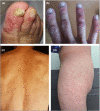Classification of the cutaneous manifestations of COVID-19: a rapid prospective nationwide consensus study in Spain with 375 cases
- PMID: 32348545
- PMCID: PMC7267236
- DOI: 10.1111/bjd.19163
Classification of the cutaneous manifestations of COVID-19: a rapid prospective nationwide consensus study in Spain with 375 cases
Abstract
Background: The cutaneous manifestations of COVID-19 disease are poorly characterized.
Objectives: To describe the cutaneous manifestations of COVID-19 disease and to relate them to other clinical findings.
Methods: We carried out a nationwide case collection survey of images and clinical data. Using a consensus we described five clinical patterns. We later described the association of these patterns with patient demographics, the timing in relation to symptoms of the disease, the severity and the prognosis.
Results: The lesions may be classified as acral areas of erythema with vesicles or pustules (pseudo-chilblain) (19%), other vesicular eruptions (9%), urticarial lesions (19%), maculopapular eruptions (47%) and livedo or necrosis (6%). Vesicular eruptions appear early in the course of the disease (15% before other symptoms). The pseudo-chilblain pattern frequently appears late in the evolution of the COVID-19 disease (59% after other symptoms), while the rest tend to appear with other symptoms of COVID-19. The severity of COVID-19 shows a gradient from less severe disease in acral lesions to more severe in the latter groups. The results are similar for confirmed and suspected cases, in terms of both clinical and epidemiological findings. Alternative diagnoses are discussed but seem unlikely for the most specific patterns (pseudo-chilblain and vesicular).
Conclusions: We provide a description of the cutaneous manifestations associated with COVID-19 infection. These may help clinicians approach patients with the disease and recognize cases presenting with few symptoms. What is already known about this topic? Previous descriptions of cutaneous manifestations of COVID-19 were case reports and mostly lacked illustrations. What does this study add? We describe a large, representative sample of patients with unexplained skin manifestations and a diagnosis of COVID-19, using a consensus method to define morphological patterns associated with COVID-19. We describe five clinical patterns associated with different patient demographics, timing and prognosis, and provide illustrations of these patterns to allow for easy recognition.
© 2020 British Association of Dermatologists.
Figures


Comment in
-
Diagnostic and prognostic values of cutaneous manifestations in COVID-19.Dermatol Ther. 2020 Jul;33(4):e13650. doi: 10.1111/dth.13650. Epub 2020 Jun 2. Dermatol Ther. 2020. PMID: 32445279 Free PMC article. No abstract available.
-
Oral manifestations in coronavirus disease 2019 (COVID-19).Oral Dis. 2021 Apr;27 Suppl 3(Suppl 3):770. doi: 10.1111/odi.13463. Epub 2020 Jul 8. Oral Dis. 2021. PMID: 32506730 Free PMC article. No abstract available.
-
Viral enanthema in oral mucosa: A possible diagnostic challenge in the COVID-19 pandemic.Oral Dis. 2021 Apr;27 Suppl 3(Suppl 3):776-778. doi: 10.1111/odi.13473. Epub 2020 Jul 21. Oral Dis. 2021. PMID: 32521564 Free PMC article. No abstract available.
-
SARS-CoV-2 infection: the same virus can cause different cutaneous manifestations.Br J Dermatol. 2020 Oct;183(4):788. doi: 10.1111/bjd.19311. Epub 2020 Jul 13. Br J Dermatol. 2020. PMID: 32533844 Free PMC article.
-
Response to 'Classification of the cutaneous manifestations of COVID-19: a rapid prospective nationwide consensus study in Spain with 375 cases': vesicular eruption in COVID-19 - to exclude varicella.Br J Dermatol. 2020 Oct;183(4):790-791. doi: 10.1111/bjd.19347. Epub 2020 Jul 27. Br J Dermatol. 2020. PMID: 32613618 Free PMC article.
-
A viral rash: the impact of COVID-19 infection on the skin.Br J Dermatol. 2020 Jul;183(1):1-2. doi: 10.1111/bjd.19188. Br J Dermatol. 2020. PMID: 32613651 Free PMC article.
-
Five common skin manifestations of COVID-19 identified.Br J Dermatol. 2020 Jul;183(1):e16. doi: 10.1111/bjd.19204. Br J Dermatol. 2020. PMID: 32745249 Free PMC article.
-
COVID-19-associated cutaneous manifestations: does human herpesvirus 6 play an aetiological role?Br J Dermatol. 2021 Jun;184(6):1187-1190. doi: 10.1111/bjd.19806. Epub 2021 Mar 1. Br J Dermatol. 2021. PMID: 33420720 Free PMC article. No abstract available.
-
Granuloma annulare triggered by SARS-CoV-2 infection: Immunohistochemical staining.Dermatol Ther. 2021 May;34(3):e14897. doi: 10.1111/dth.14897. Epub 2021 Mar 3. Dermatol Ther. 2021. PMID: 33599069 Free PMC article. No abstract available.
References
-
- Phelan AL, Katz R, Gostin LO. The novel coronavirus originating in Wuhan, China: challenges for global health governance. JAMA 2020; DOI: 10.1001/jama.2020.1097. - PubMed
-
- Recalcati S. Cutaneous manifestations in COVID‐19: a first perspective. J Eur Acad Dermatol Venereol 2020; 34:e212–13. - PubMed
-
- Mazzota F, Troccoli T. Acute acro‐ischemia in the child at the time of COVID‐19. Available at: https://www.fip-ifp.org/wp-content/uploads/2020/04/acroischemia-ENG.pdf (last accessed 4 May 2020).
MeSH terms
LinkOut - more resources
Full Text Sources
Medical

